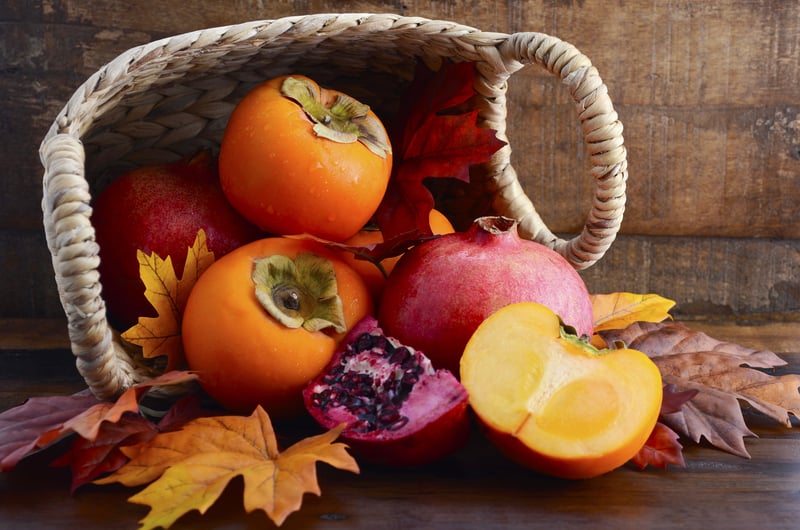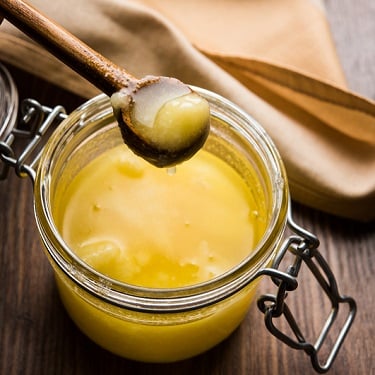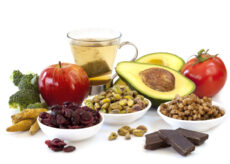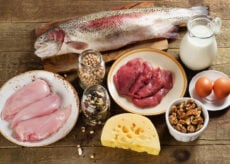18 Fall and Winter Superfoods to Support Your Health

When you change your wardrobe for a new season, it’s also a good time to look at the foods you keep in the fridge and pantry. After all, as the winter winds bring in rain, snow, or at least some chills, the seasonal vegetables change from light, bright summer finds to hearty winter superfoods.
Of course, eating with the season is nothing new. In generations past, it wasn’t easy to transport produce from warmer, more moderate climates to areas that enjoyed all four seasons. So, you ate what you grew and stored along with what was available for that season. Spring and summer brought flavorful stone fruits, melons, and plenty of delicate greens, while fall made way for winter superfoods like apples, pumpkins, and more hearty greens.
Now, though, enhanced transportation has changed all of that. We can get almost anything we’re craving just about any time of the year from all around the globe. So, is there any reason to eat seasonally?
Absolutely! And, here are just a few of the top reasons:
- Food tastes the freshest and most flavorful when it doesn’t have to be shipped over long distances.
- It supports local farmers and keeps money within your own community, which promotes a stronger local economy. While some farmers’ markets stay open year-round, if yours does not, fortunately, more and more grocery stores are stocking local foods, so you can still invest in local growers.
- It’s less expensive because you’re buying the foods that are abundant rather than more difficult to find.
- It encourages you to try new foods or at least to switch up your recipes and get out of a food rut.
- You increase the variety of nutrients you eat and potentially get more nutrients from the foods you eat as they’re picked closer to peak and thus are higher in vitamins C and E, folate, antioxidants, and more.
- It’s more friendly to the environment as it doesn’t need to be shipped long distances to make it to your local food store, which means it takes less fuel to transport. This can also save on costs.
RELATED: Collagen Doesn’t Work (Unless…)
So, what vegetables and fruits are in season in the fall and winter months?
18+ Fall and Winter Superfoods
1. Apples
From late summer into early winter, you’ll find these red, round balls of flavor on trees around the country. Don’t stop at bobbing for apples in late October. Enjoy them throughout the cold winter season to help support a healthy immune system (they’re a rich source of vitamin C). In addition, they contain high amounts of the soluble fiber pectin, which has many health benefits, including supporting healthy levels of blood fats. Apples can be added to a variety of recipes (including a tasty pumpkin-spiced pork tenderloin) but are most commonly enjoyed as a crisp, fresh snack, perhaps with a side of nut butter.
2. Beets
With their earthy flavor, brilliant color, and burst of nutrition, the humble beet deserves its place at any table. It’s high in folate, beta-carotene, and potassium. Beets are the star of the show in borscht (a Russian-style beet soup) but can also be roasted, pickled, or shredded for a colorful, nutrient-dense salad.
3. Brussels Sprouts
In terms of taste and nutrient density, few winter foods top this unusual veggie. Included in the cruciferous vegetable family, Brussels sprouts are rich in vitamins C, B6, and K, folate, magnesium, and potassium. Perhaps the easiest, most flavorful way to enjoy them is roasted with just a touch of oil, salt and pepper, and perhaps some bacon or a splash of lemon juice.
If you aren’t a fan of Brussels Sprouts, other cruciferous vegetables (arugula [aka rocket], broccoli, broccoli rabe, cabbage, white, purple, green, and orange cauliflower) are at their peak in the fall and winter. They’re all rich in vitamin C and may even help lower the risk of cancer as they provide the nutrient sulforaphane.
4. Chicories (endive, escarole, and radicchio)
These cold-weather-friendly winter superfoods provide a big burst of flavor and color that’s pleasing to the eyes. Plus, they’re rich in fiber and vitamins and minerals like vitamin A, folate, potassium, calcium, and magnesium. They’re slightly bitter when raw. Fortunately, they can be added to soups, wraps, and even made into dips that can support their strong flavor.
5. Citrus Fruits (oranges, clementines, grapefruits, tangelos, and lemons)
Once cold and flu season hits, many of us are reaching for foods bursting with vitamin C. And fortunately, some of the tastiest citrus fruits hit peak ripeness in the coldest, snowiest months. Look for blood and navel oranges to add to a salad or enjoy for a snack, have a half grapefruit as part of your healthy breakfast, or brighten any recipe or even a cup of tea with a squeeze from a fresh lemon wedge.
6. Cranberries
There’s a good reason cranberries are included in so many holiday recipes. These nutrient powerhouses provide a big burst of flavor when fresh, frozen, dried, canned, or sauced. They offer nutrients that may even support a healthy urinary tract as well as cardiovascular health. Just keep the added sugars to a minimum.
7. Fennel
Best known for its sweet licorice-like flavor, every part of the fennel plant is edible and can be served raw in salads, roasted, or in soups, stuffings, and broths. It’s nutrient-dense, making it a strong winter superfood that provides fiber, potassium, calcium, magnesium, manganese, phosphorous, and copper.
8. Garlic
Support a healthy immune system with garlic, which is known for its antimicrobial and antibiotic properties as well as its intense flavor.
9. Ginger
You’ll find a lot of winter favorites flavored with this warming spice, from gingerbread and gingersnaps to winter soups to grilled meats to Asian dishes. Ginger is especially helpful in the winter as it has been used for generations to help soothe an upset stomach, improve digestion, stimulate circulation, and support a healthy immune system.
10. Kale
One of the most popular hearty winter foods is kale. It’s so versatile and provides a wealth of nutrients, including potassium and folate. Add it to savory soups, shred it for salads, or even snack on kale chips.
11. Leeks
Slightly milder than onions, leeks are delicious in soups and salads as well as roasted. They’re also a good source of magnesium, which many of us simply don’t get enough of.
12. Parsnips
Potatoes, beets, and other root vegetables are more common, but once you taste a parsnip, you will likely become a fan. They’re mildly sweet, similar to a richly flavored carrot, and can even be used in place of or as companions to carrots in many recipes. Add them to winter soups and stews, roasted vegetables, or even boil and mash them like potatoes. They’re a good choice as they’re also rich in fiber and folate. Other less common root vegetables to include in your winter food pantry include rutabagas and turnips.
13. Pears
Apples tend to steal the show as a popular fall and winter fruit, but don’t overlook pears. These delicious fruits are rich in vitamins B2, E, copper, and pectin. They’re just as good baked as fresh and offer a sweet elegance perfect for cold-weather desserts.
14. Persimmons
Another winter food that many folks are unfamiliar with is the humble persimmon. It’s worth giving a try, though, as it’s very nutrient-dense and packs a big punch in a small size. For example, this mildly sweet fruit provides a good dose of vitamin A, which is vital for eye health and immune function. You can find two versions. The Fuyu persimmon is firm and can be cut up like an apple or pear. The Hachiya persimmon is softer and is served more like an avocado. That is, you’ll cut it in half and scoop the soft flesh out of each half to enjoy.
If you don’t see persimmons at your grocery store, other unusual winter superfruits to try include passion fruit and kiwi, which are both high in immune-supporting vitamin C.
15. Pomegranates
These jewel-like seeds are popular for their brilliant color, making them a delight to see in holiday recipes. They’re also delicious, high in fiber and free-radical-fighting polyphenols, which may support heart health, help fight infections, and even promote memory. Include them in a winter salad or just tossed on top of a smoothie bowl or chia seed pudding to make them extra special.
16. Potatoes
While some consider potatoes off the menu due to their high carb content, they are one of the most satiating foods you can find. They also are easy to digest and nutrient-rich. Plus, they’re so versatile and easy to make and are well-known as a warming comfort food.
17. Sweet Potatoes
These beta-carotene powerhouses provide a potent antioxidant punch and are at their best from October through December. Add some to your winter soups and chilis, serve them baked as a sweet side (especially with a sprinkle of cinnamon), as fries, or even top them with your favorite meat and BBQ sauce.
18. Winter Squash (Acorn, Butternut, and Pumpkin)
Winter squashes are abundant in early fall and throughout the winter. They aren’t only tasty (with a little butter or a spray of oil and some spices, roasted, or added to a squash soup), but they provide fiber and are a rich source of beta-carotene, vitamins B6 and C, and magnesium.
Winter Superfoods Wrap-Up
Even when the weather turns and it’s time to pull out your parka (depending on where you live), you can still enjoy a wide variety of fruits and vegetables. If you’re looking for those in the fresh produce section, focusing on the list above can provide more flavor and nutrition. But if you miss some of your favorite options, you don’t have to wait until summer. You may still find them in the produce section. Or, head to the frozen or canned section to increase the variety even further.
Then round out the rest of your winter superfoods menu with other healthy options, including cold-weather-friendly proteins (e.g., lean meats, fatty fish, shellfish, eggs, yogurt, and beans), fiber-rich grains (e.g., oats, millet, and quinoa), nuts and seeds (e.g., pistachios, peanuts, chia, sesame), warming seasonings (such as, turmeric, cayenne pepper, cinnamon), and hot beverages (e.g., green, black, or herbal tea) to help you stay warm and healthy no matter how low the temperatures drop.





 US Doctor: "Eating This Every Day Can Snap You Into Ketosis"
US Doctor: "Eating This Every Day Can Snap You Into Ketosis" 3 Key Nutrients to Help Lubricate Your "Tin Man" Joints
3 Key Nutrients to Help Lubricate Your "Tin Man" Joints AVOID Plant-Based Protein Powders (unless...)
AVOID Plant-Based Protein Powders (unless...)

